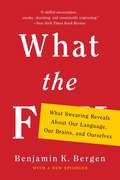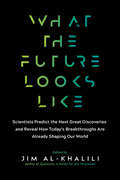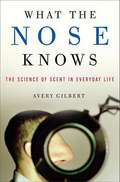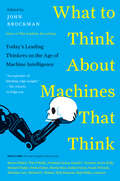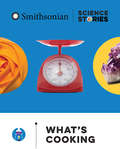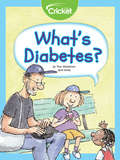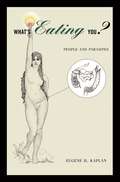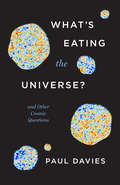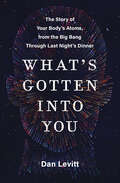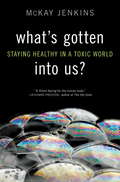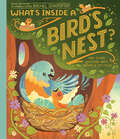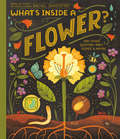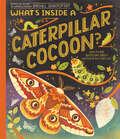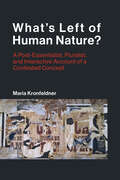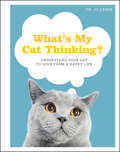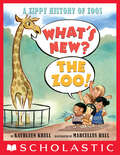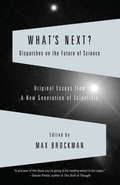- Table View
- List View
What the F: What Swearing Reveals About Our Language, Our Brains, And Ourselves
by Benjamin K. BergenIt may be starred, beeped, and censored--yet profanity is so appealing that we can't stop using it. In the funniest, clearest study to date, Benjamin Bergen explains why, and what that tells us about our language and brains.Nearly everyone swears-whether it's over a few too many drinks, in reaction to a stubbed toe, or in flagrante delicto. And yet, we sit idly by as words are banned from television and censored in books. We insist that people excise profanity from their vocabularies and we punish children for yelling the very same dirty words that we'll mutter in relief seconds after they fall asleep. Swearing, it seems, is an intimate part of us that we have decided to selectively deny.That's a damn shame. Swearing is useful. It can be funny, cathartic, or emotionally arousing. As linguist and cognitive scientist Benjamin K. Bergen shows us, it also opens a new window onto how our brains process language and why languages vary around the world and over time.In this groundbreaking yet ebullient romp through the linguistic muck, Bergen answers intriguing questions: How can patients left otherwise speechless after a stroke still shout Goddamn! when they get upset? When did a cock grow to be more than merely a rooster? Why is crap vulgar when poo is just childish? Do slurs make you treat people differently? Why is the first word that Samoan children say not mommy but eat shit? And why do we extend a middle finger to flip someone the bird?Smart as hell and funny as fuck, What the F is mandatory reading for anyone who wants to know how and why we swear.
What the Future Looks Like: Scientists Predict the Next Great Discoveries and Reveal How Today's Breakthroughs Are Already Shaping Our World
by Jim Al-KhaliliGet the science facts, not science fiction, on the cutting-edge developments that are already changing the course of our future.Every day, scientists conduct pioneering experiments with the potential to transform how we live. Yet it isn’t every day you hear from the scientists themselves! Now, award–winning author Jim Al–Khalili and his team of top-notch experts explain how today’s earthshaking discoveries will shape our world tomorrow—and beyond.Pull back the curtain on: genomicsroboticsAIthe “Internet of Things”synthetic biologytranshumanisminterstellar travelcolonization of the solar systemteleportationand much moreAnd find insight into big–picture questions such as:Will we find a cure to all diseases? The answer to climate change? And will bionics one day turn us into superheroes?The scientists in these pages are interested only in the truth—reality-based and speculation-free. The future they conjure is by turns tantalizing and sobering: There’s plenty to look forward to, but also plenty to dread. And undoubtedly the best way to for us to face tomorrow’s greatest challenges is to learn what the future looks like—today.Praise for What the Future Looks Like“A collection of mind-boggling essays that are just the thing for firing up your brain cells.” —Saga Magazine“The predictions and impacts are global . . . [and] the book contains far more fascinating information than can be covered in this review.” —Choice“This book is filled with essays from experts offering their informed opinions on what the science and technology of today will look like in the future, from smart materials to artificial intelligence to genetic editing.” —Popular Science“Fun is an understatement. This is a great collection to get the summer book season started.” —Forbes.com“The focus on sincere, factual presentation of current and future possibilities by leading experts is particularly welcome in this era of fake news and anti-science rhetoric.” —Library Journal
What the Nose Knows (Fountas & Pinnell LLI Purple #Level Q)
by Patrick WinterHumans can detect about 10,000 different smells, but most people experience the world only through their eyes and ears, often neglecting smell. By paying attention to the sense of smell and understanding how it works, people can learn more about the world they live in, about themselves, and about their relationships
What the Nose Knows: The Science of Scent in Everyday Life
by Avery GilbertAvery Gilbert is one of only a handful of psychologists in America who study olfaction. There's nowhere to get trained directly in the business; you can't enroll for a PhD in Perfume Studies. With What the Nose Knows, Gilbert takes us inside his work and the realm of smell, giving a fascinating account of the familiar yet mysterious world of scent that is grounded in science but often ends up showing us a reflection of our culture. He sets out to answer the questions he is most often asked: Is the ephemeral nature of odours due to their physical makeup, or to the way our brains process information? Do animals have a keener sense of smell than humans, and how can we tell? How do scents--a mere collection of airborne molecules--become powerful carriers of symbolic meaning? Do odors alter our emotions or behaviour, and is it ethical for companies to try to surreptitiously influence customers with scent? The link between smell and memory is well known--but is it actually an illusion?
What to Think About Machines That Think: Today's Leading Thinkers on the Age of Machine Intelligence
by Mr John BrockmanAs the world becomes ever more dominated by technology, John Brockman’s latest addition to the acclaimed and bestselling “Edge Question Series” asks more than 175 leading scientists, philosophers, and artists: What do you think about machines that think? <P><P> The development of artificial intelligence has been a source of fascination and anxiety ever since Alan Turing formalized the concept in 1950. Today, Stephen Hawking believes that AI “could spell the end of the human race.” At the very least, its development raises complicated moral issues with powerful real-world implications—for us and for our machines. <P> In this volume, recording artist Brian Eno proposes that we’re already part of an AI: global civilization, or what TED curator Chris Anderson elsewhere calls the hive mind. And author Pamela McCorduck considers what drives us to pursue AI in the first place. <P> On the existential threat posed by superintelligent machines, Steven Pinker questions the likelihood of a robot uprising. Douglas Coupland traces discomfort with human-programmed AI to deeper fears about what constitutes “humanness.” Martin Rees predicts the end of organic thinking, while Daniel C. Dennett explains why he believes the Singularity might be an urban legend.
What's Alive?
by Kathleen Weidner ZoehfeldYou don't look like a cat. But you and a cat have something in common: You both are alive. People and plants and animals are all alive, but is a doll alive? Or your tricycle? How can you tell? Read and find out what makes something alive, and what all living things need to stay healthy.
What's Alive? (Let's-Read-and-Find-Out Science 1)
by Kathleen Weidner ZoehfeldRead and find out about what makes something alive, and what all living things need to stay healthy, in this colorfully illustrated nonfiction picture book.A person and a cat have something in common: You are both alive. People and plants and animals are all alive, but is a doll alive? Or your bike? How can you tell?This is a clear and appealing science book for early elementary age kids, both at home and in the classroom. It's a Level 1 Let's-Read-and-Find-Out, which means the book explores introductory concepts perfect for children in the primary grades. The 100+ titles in this leading nonfiction series are:hands-on and visualacclaimed and trustedgreat for classroomsTop 10 reasons to love LRFOs:Entertain and educate at the same timeHave appealing, child-centered topicsDevelopmentally appropriate for emerging readersFocused; answering questions instead of using survey approachEmploy engaging picture book quality illustrationsUse simple charts and graphics to improve visual literacy skillsFeature hands-on activities to engage young scientistsMeet national science education standardsWritten/illustrated by award-winning authors/illustrators & vetted by an expert in the fieldOver 130 titles in print, meeting a wide range of kids' scientific interestsBooks in this series support the Common Core Learning Standards, Next Generation Science Standards, and the Science, Technology, Engineering, and Math (STEM) standards. Let's-Read-and-Find-Out is the winner of the American Association for the Advancement of Science/Subaru Science Books & Films Prize for Outstanding Science Series.
What's Diabetes?
by Thor WickstromA brave young girl named Irene talks about a disease she has—type 1 diabetes—and how she and her dad work together to keep her healthy. Irene and her father teach all of her friends about her disease and how it can affect someone's body. She teaches them about blood sugar tests, insulin, and why and how people have diabetes. By teaching all of her friends about diabetes, she is able to teach everyone at the park that while she might have a disease, it does not mean she is not a normal little girl.
What's Eating You?: Parasites--the Inside Story
by Nicola DaviesThe creators of Poop and Extreme Animals return with this in-depth look at how parasites--mites, lice, fleas, ticks, and tapeworms--make their homes on (and in) other creatures, including humans. Full color.
What's Eating You?: People and Parasites
by Eugene H. KaplanEverything you ever wanted to know about parasites but were too horrified to askIn What's Eating You? Eugene Kaplan recounts the true and harrowing tales of his adventures with parasites, and in the process introduces readers to the intimately interwoven lives of host and parasite.Kaplan has spent his life traveling the globe exploring oceans and jungles, and incidentally acquiring parasites in his gut. Here, he leads readers on an unforgettable journey into the bizarre yet oddly beautiful world of parasites. In a narrative that is by turns frightening, disgusting, and laugh-out-loud funny, Kaplan describes how drinking contaminated water can cause a three-foot-long worm to burst from your arm; how he "gave birth" to a parasite the size and thickness of a pencil while working in Israel; why you should never wave a dead snake in front of your privates; and why fleas are attracted to his wife. Kaplan tells stories about leeches feasting on soldiers in Vietnam; sea cucumbers with teeth in their anuses that seem to encourage the entry of symbiotic fish; the habits of parasites that cause dysentery, river blindness, and other horrifying diseases--and much, much more. Along the way, he explains the underlying science, including parasite evolution and host-parasite physiology.Informative, frequently lurid, and hugely entertaining, this beautifully illustrated book is a must-read for health-conscious travelers, and anyone who has ever wondered if they picked up a tapeworm from that last sushi dinner.
What's Eating the Universe?: And Other Cosmic Questions
by Paul DaviesCombining the latest scientific advances with storytelling skills unmatched in the cosmos, an award-winning astrophysicist and popular writer leads us on a tour of some of the greatest mysteries of our universe. In the constellation of Eridanus there lurks a cosmic mystery: It’s as if something has taken a huge bite out of the universe. But what is the culprit? The hole in the universe is just one of many puzzles keeping cosmologists busy. Supermassive black holes, bubbles of nothingness gobbling up space, monster universes swallowing others—these and many other bizarre ideas are being pursued by scientists. Due to breathtaking progress in astronomy, the history of our universe is now better understood than the history of our own planet. But these advances have uncovered some startling riddles. In this electrifying new book, renowned cosmologist and author Paul Davies lucidly explains what we know about the cosmos and its enigmas, exploring the tantalizing—and sometimes terrifying—possibilities that lie before us. As Davies guides us through the audacious research offering mind-bending solutions to these and other mysteries, he leads us up to the greatest outstanding conundrum of all: Why does the universe even exist in the first place? And how did a system of mindless, purposeless particles manage to bring forth conscious, thinking beings? Filled with wit and wonder, What’s Eating the Universe? is a dazzling tour of cosmic questions, sure to entertain, enchant, and inspire us all.
What's Eating the Universe?: And Other Cosmic Questions
by Paul DaviesCombining the latest scientific advances with storytelling skills unmatched in the cosmos, an award-winning astrophysicist and popular writer leads us on a tour of some of the greatest mysteries of our universe. In the constellation of Eridanus there lurks a cosmic mystery: It’s as if something has taken a huge bite out of the universe. But what is the culprit? The hole in the universe is just one of many puzzles keeping cosmologists busy. Supermassive black holes, bubbles of nothingness gobbling up space, monster universes swallowing others—these and many other bizarre ideas are being pursued by scientists. Due to breathtaking progress in astronomy, the history of our universe is now better understood than the history of our own planet. But these advances have uncovered some startling riddles. In this electrifying new book, renowned cosmologist and author Paul Davies lucidly explains what we know about the cosmos and its enigmas, exploring the tantalizing—and sometimes terrifying—possibilities that lie before us. As Davies guides us through the audacious research offering mind-bending solutions to these and other mysteries, he leads us up to the greatest outstanding conundrum of all: Why does the universe even exist in the first place? And how did a system of mindless, purposeless particles manage to bring forth conscious, thinking beings? Filled with wit and wonder, What’s Eating the Universe? is a dazzling tour of cosmic questions, sure to entertain, enchant, and inspire us all.
What's Faster Than A Speeding Cheetah?
by Robert E. WellsWhat's faster than a cheetah?--no animal on earth can run faster. But a peregrine falcon can swoop faster than a cheetah can run. And the falcon can't compare to an airplane, a rocket, or the speed of light.
What's Faster Than a Speeding Cheetah?
by Robert E WellsWhat's faster than a cheetah?--no animal on earth can run faster. But a peregrine falcon can swoop faster than a cheetah can run. And the falcon can't compare to an airplane, a rocket, or the speed of light. Lively text and watercolors will make children laugh while they learn all about speed.
What's Gotten Into You: The Story of Your Body's Atoms, from the Big Bang Through Last Night's Dinner
by Dan LevittFor readers of Bill Bryson, Neil deGrasse Tyson and Siddhartha Mukherjee, a wondrous, wildly ambitious, and vastly entertaining work of popular science that tells the awe-inspiring story of the elements that make up the human body, and how these building blocks of life travelled billions of miles and across billions of years to make us who we are.Every one of us contains a billion times more atoms than all the grains of sand in the earth’s deserts. If you weigh 150 pounds, you’ve got enough carbon to make 25 pounds of charcoal, enough salt to fill a saltshaker, enough chlorine to disinfect several backyard swimming pools, and enough iron to forge a 3-inch nail. But how did these elements combine to make us human? All matter—everything around us and within us—has an ultimate birthday: the day the universe was born. This informative, eye-opening, and eminently readable book is the story of our atoms’ long strange journey from the Big Bang to the creation of stars, through the assembly of Planet Earth, and the formation of life as we know it. It’s also the story of the scientists who made groundbreaking discoveries and unearthed extraordinary insights into the composition of life. Behind their unexpected findings were investigations marked by fierce rivalries, obsession, heartbreak, flashes of insight, and flukes of blind luck. Ultimately they’ve helped us understand the mystery of our existence: how a quadrillion atoms made of particles from the Big Bang now animate each of our cells.Shaped by the curious mind and bold vision of science and history documentarian Dan Levitt, this wondrous book is no less than the story of life itself.
What's Gotten into Us? Staying Healthy in a Toxic World
by Mckay JenkinsDo you know what chemicals are in your shampoo? How about your cosmetics? Do you know what's in the plastic water bottles you drink from, or the weed killer in your garage, or your children's pajamas? If you're like most of us, the answer is probably no. But you also probably figured that most of these products were safe, and that someone--the manufacturers, the government--was looking out for you. The truth might surprise you.After experiencing a health scare of his own, journalist McKay Jenkins set out to discover the truth about toxic chemicals, our alarming levels of exposure, and our government's utter failure to regulate them effectively. The result of his two-year journey, What's Gotten into Us?, is a deep, remarkable, and empowering investigation into the threats--biological and environmental--that chemicals now present in our daily lives. It reveals how dangerous, and how common, toxins are in the most ordinary things, and in the most familiar of places: * Our water: Thanks to suburban sprawl and agricultural runoff, 97 percent of our nation's rivers and streams are now contaminated with everything from herbicides to pharmaceutical drugs. * Our bodies: High levels of hormone-disrupting chemicals from cosmetics, flame-retardants from clothing and furniture, even long-banned substances like DDT and lead, are consistently showing up in human blood samples. * Our homes: Many toxins lurk beneath our sinks and in our basements, of course, but did you know that they're also found in wall-to-wall carpeting, plywood, and fabric softeners? * Our yards: Pesticides, fungicides, even common fertilizers--there are enormous, unseen costs to our national obsession with green, weed-free lawns. What's Gotten Into Us? is much more than a wake-up call. It offers numerous practical ways for us to regain some control over our lives, to make our own personal worlds a little less toxic. Inside, you'll find ideas to help you make informed decisions about the products you buy, and to disentangle yourself from unhealthy products you don't need--so that you and your family can start living healthier lives now, and in the years to come. Because, as this book shows, what you don't know can hurt you.From the Hardcover edition.
What's Inside A Bird's Nest?: And Other Questions About Nature & Life Cycles (What's Inside)
by Rachel IgnotofskyDiscover the next nonfiction picture book about eggs, nests, and birds from the creator of the New York Times bestseller Women in Science, Rachel Ignotofsky! Want to learn more about the bird that chirps outside your window? Ignotofsky crafts a perfect read out loud with a touch of humor and compassion for our friends with wings in the sky!Find out more from the moment they hatch, to how they create their homes in this perfectly detailed and soon-to-be springtime favorite read!Rachel Ignotofsky's beautiful, distinctive art style and engaging, informative text clearly answers any questions a child (or adult) could have about birds, eggs, and nests in this nonfiction picture book series.
What's Inside A Flower?: And Other Questions About Science & Nature (What's Inside)
by Rachel IgnotofskyFrom the creator of the New York Times bestseller Women in Science, comes a new nonfiction picture book series ready to grow young scientists by nurturing their curiosity about the natural world--starting with what's inside a flower.Budding backyard scientists can start exploring their world with this stunning introduction to these flowery show-stoppers--from seeds to roots to blooms. Learning how flowers grow gives kids beautiful building blocks of science and inquiry.In the launch of a new nonfiction picture book series, Rachel Ignotofsky's distinctive art style and engaging, informative text clearly answers any questions a child (or adult) could have about flowers.
What's Inside a Caterpillar Cocoon?: And Other Questions About Moths & Butterflies (What's Inside)
by Rachel IgnotofskyWith warm and heart-fluttering illustrations, discover the next nonfiction picture book about butterflies and moths from the creator of the New York Times bestseller Women in Science!Butterflies soar in the sunlight. While moths flutter under the moon and stars.Find out more about these mysterious and majestic insects similarities and differences, and their awestrucking metamorphosis! Rachel Ignotofsky's distinctive art style and engaging, informative text clearly answers any questions a child (or adult) could have about butterflies and moths in this nonfiction picture book series.
What's Left of Human Nature?: A Post-Essentialist, Pluralist, and Interactive Account of a Contested Concept (Life and Mind: Philosophical Issues in Biology and Psychology)
by Maria KronfeldnerA philosophical account of human nature that defends the concept against dehumanization, Darwinian, and developmentalist challenges.Human nature has always been a foundational issue for philosophy. What does it mean to have a human nature? Is the concept the relic of a bygone age? What is the use of such a concept? What are the epistemic and ontological commitments people make when they use the concept? In What's Left of Human Nature? Maria Kronfeldner offers a philosophical account of human nature that defends the concept against contemporary criticism. In particular, she takes on challenges related to social misuse of the concept that dehumanizes those regarded as lacking human nature (the dehumanization challenge); the conflict between Darwinian thinking and essentialist concepts of human nature (the Darwinian challenge); and the consensus that evolution, heredity, and ontogenetic development result from nurture and nature.After answering each of these challenges, Kronfeldner presents a revisionist account of human nature that minimizes dehumanization and does not fall back on outdated biological ideas. Her account is post-essentialist because it eliminates the concept of an essence of being human; pluralist in that it argues that there are different things in the world that correspond to three different post-essentialist concepts of human nature; and interactive because it understands nature and nurture as interacting at the developmental, epigenetic, and evolutionary levels. On the basis of this, she introduces a dialectical concept of an ever-changing and “looping” human nature. Finally, noting the essentially contested character of the concept and the ambiguity and redundancy of the terminology, she wonders if we should simply eliminate the term “human nature” altogether.
What's My Cat Thinking?: Understand Your Cat to Give Them a Happy Life
by Jo LewisHave you ever wondered why your cats behave the way they do? This authoritative guide has all the answers! Cats are weird, and sometimes their behavior can leave you scratching your head. Discover what&’s really behind those things cats do – whether they&’re amusing, irritating or just downright bizarre.What&’s My Cat Thinking will help cat lovers unlock the secret code of cats for a deeper connection with the feline in your life. Inside, you&’ll find: • Accurate descriptions of behavior will help you understand your cat&’s body language nuances and act accordingly. • Covers a range of breeds. • A fun book for cat people that delivers practical, helpful advice from acknowledged experts on a range of tricky or puzzling cat behaviors. Have you ever wondered why your cat sleeps on your keyboard, why they bully the dog or why they insist on drinking from the bathroom tap — or if they even like you? Cats (unlike the dogs they look down on) are not always easy to understand. This cat psychology book will show you that they do show their feelings, albeit subtly, in the way they relate to you, other animals and their home environment. Stunning illustrations of a wide range of breeds and informative text will help you understand your cat's body language, so you know when they are happy and when they aren&’t! Aside from learning to understand your cat, this guide includes &“catwatching&” spreads that provide helpful tips and advice on dealing with some common kitty challenges like moving home and introducing a new cat into the family. So when they are sitting on your head at 4 a.m., you will at least know why!
What's New? The Zoo!: A Zippy History of Zoos
by Kathleen KrullWith friendly facts, funny pictures, and animals galore, What's New? The Zoo! is history to roar for!Did you know . . . * The first zoo was established forty-three hundred years ago in what is now Iraq?* Aztec King Moctezuma II had such an incredible collection of animals that it took six hundred men and women to care for them?* Children across Great Britain wrote to Queen Victoria when Jumbo the elephant was sold away from the London Zoo?* Fifty buffalo passed through Grand Central Station in 1907 on their way to the Bronx Zoo?* Zoos now play a crucial role in animal conservation?Kathleen Krull and Marcellus Hall bring witty insight, jazzy style, and a globe-trotting eye to our millennia-long history of keeping animals -- and the ways animals have changed us in turn.
What's Next? Dispatches on the Future of Science
by Max BrockmanIn 'What's Next?', 18 young scientists present the futuristic ideas they are pursuing that just might change the way we look at the world, even the way we live. From climate change to cutting-edge physics, from hard-wired morality to modifying our brains or even our genome, 'What's Next?' will give its readers a head start on comprehending what may well be in store for all of us in the next few decades.
What's Older Than a Giant Tortoise?
by Robert E WellsIf medals were awarded to animals for living a long time, then a giant tortoise would certainly win one. Some giant tortoises have lived for more than 150 years! Still, there are things on this planet much older than giant tortoises. Some of the giant sequoia trees that grow in California would be more than 3,000 years old. But the trees aren't that old compared to the Barringer Crater in Arizona--that was made about 49,000 years ago. And it's almost impossible to imagine that 65 million years ago, the T. rex dinosaur roamed this planet--but we have the skeletons to prove it!
